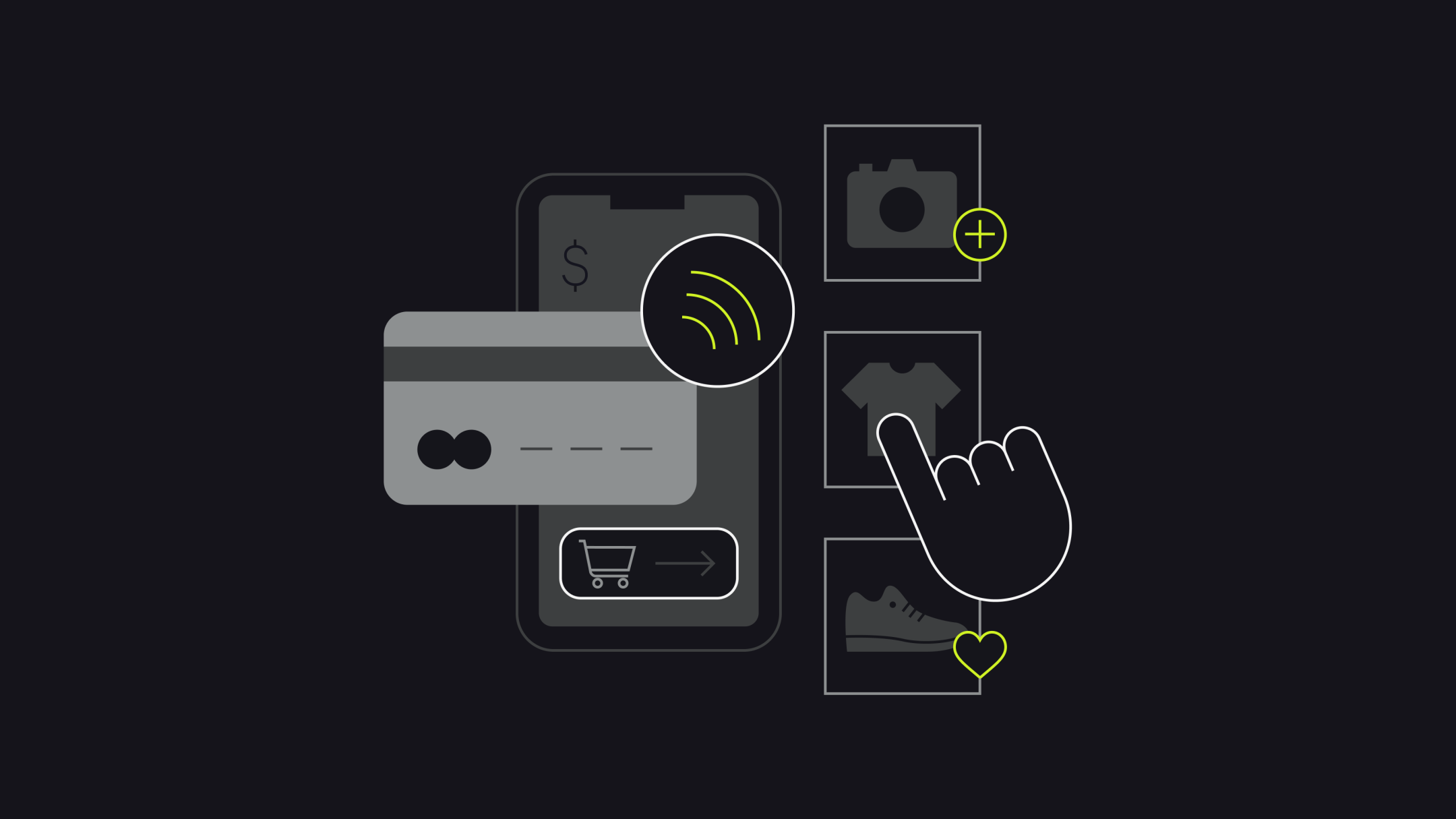Of all the shopping channels available to customers, mobile commerce is taking the lead. Mobile commerce is forecasted to have the biggest retail sales growth (12.2%) in 2021, beating traditional ecommerce and in-store shopping.
Driving this trend is the estimated 292 million people expected to have their own mobile devices by 2024. And it’s predicted that some 187.5 million of them will shop via their smartphone.
It’s no wonder global consumer mobile spending is expected to reach $270 billion by 2025.
Despite its promise, mobile commerce can be a frustrating and painful experience for consumers and businesses alike. Why? Two reasons:
- Mobile-friendly sites are all but universal.
- Mobile-friendly isn’t enough to capture mobile commerce sales.
To find out how you can capture the estimated 187.5 million mobile buyers, we dug through the latest reports, industry-wide statistics, proprietary data, and case studies on businesses dominating mobile. In this guide, you’ll find answers to your burning mobile commerce questions including:
- What is mobile commerce?
- How is mobile commerce different from ecommerce?
- What are the different types of mobile commerce?
- What are the benefits of having a mobile commerce strategy?
- When is mobile commerce not right for a business?
- Mobile commerce trends and statistics
- Examples of great mobile commerce
What is mobile commerce (m-commerce)?
Mobile commerce, also known as m-commerce, is the process of buying and selling items through a mobile device, tablet, or other handheld device. Mobile commerce transactions can be for products or services including fashion items, business software, or CPG.
The release of new phone technology—including 5G—is accelerating the shift to mobile commerce. That, plus the fact society is mobile-obsessed and more dependent on digital devices than ever. Here’s proof:
- The average person taps their cellphone once every 10 minutes (averaging three hours and 15 minutes of use) every day.
- 1 in 5 people would rather go without shoes for a week than take a break from their phone.
- People report withdrawal symptoms—including increased blood pressure and heart rate—when separated from their mobile phones.
How is mobile commerce different from ecommerce?
Historically, customers buy items online through a desktop computer. This is traditional ecommerce as we know it. However, the growth in ownership of traditional home computers has remained stagnant since 2015.
Smartphone ownership, on the other hand, is rising dramatically. Half a billion new people bought a mobile device in 2019, bringing the total number of smartphone users to a staggering 3.6 billion globally.
Mobile commerce differs from the ecommerce website experience in one main way: the person buying the product is doing so from one of these smartphones. Ecommerce retailers either need a mobile-friendly website that loads on those smaller screens, or a dedicated mobile app that customers can download to their device and purchase through.
What are the types of mobile commerce?
Mobile payment apps
Mobile applications are downloaded to a shopper’s smartphone. People can either send money to their family and friends (through apps like PayPal and Venmo) or pay for goods and services (through mobile payment apps like Shop Pay).
Data shows that almost half of mobile device owners who’ve used a retailer’s mobile app did so to discover more information about a product or service. Another 40% used the app to make a purchase. That’s likely why there was a 40% growth in shopping app downloads from 2019 to 2020.
Mobile wallets
Most mobile devices have a built-in card storage feature, such as Apple Pay, Samsung Pay, and Google Pay. They work using the same near-field communication (NFC) technology that powers other types of virtual payment, like contactless cards.
These digital wallets were used to make more payments than debit cards, bank transfers, and buy now, pay later transactions combined in 2020. The entire market for mobile wallets is expected to be worth $350 billion by 2026.
Mobile banking
Most major banks have their own mobile apps for customers to view balances and send money. M-commerce leans into that by asking a user to approve a transaction being triggered from their bank account to yours in return for goods and services.
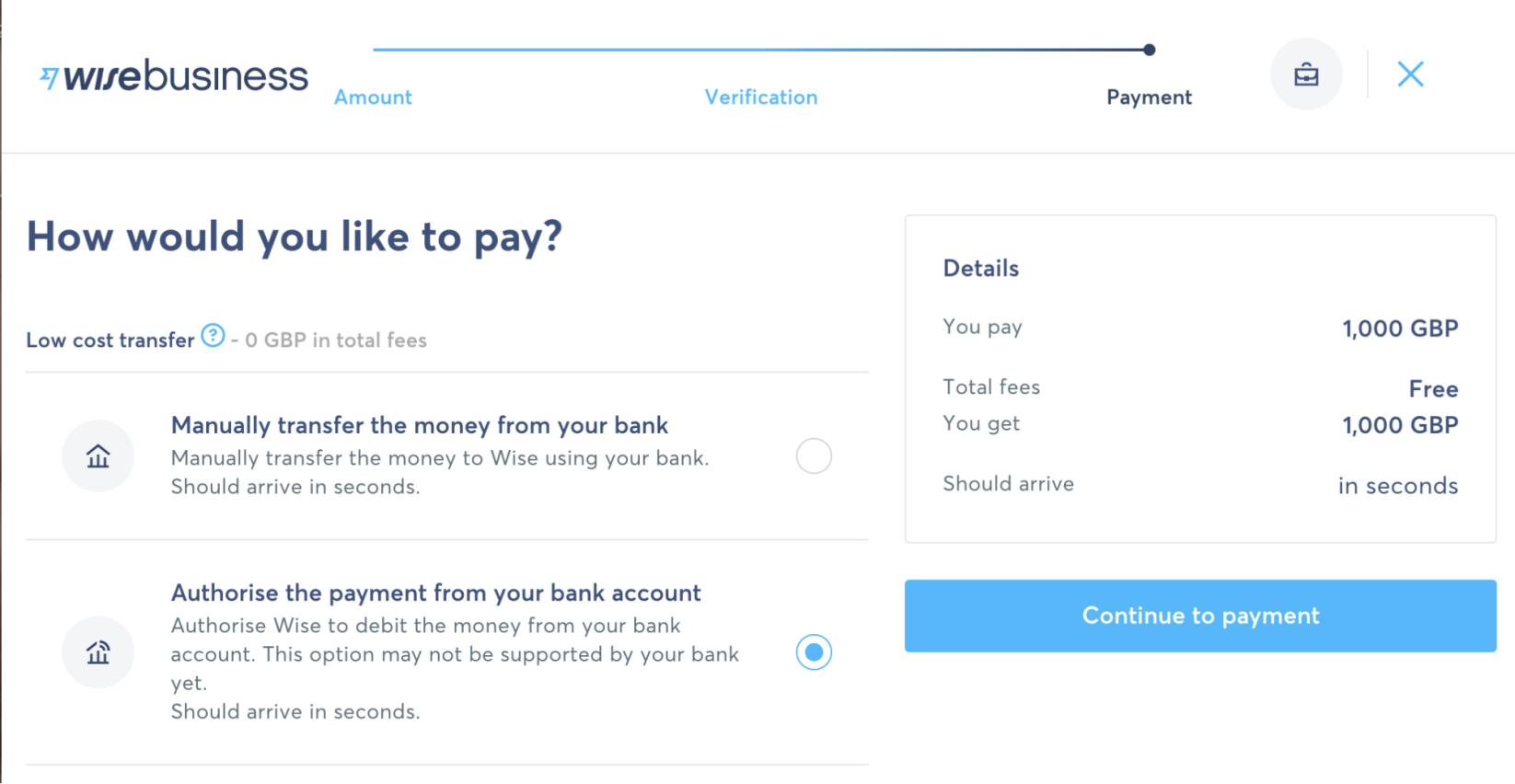
QR codes
QR codes are small square graphics shoppers scan in-store using their smartphones. Each code is unique to a specific landing page.
If you have a Shopcode at the checkout desk in your brick-and-mortar store, for example, you can direct shoppers to a personalized in-app checkout page. You can also add them to product packaging for customers to make repeat purchases via their mobile phone once a previous order has been delivered.
Either of these options pair QR codes with other types of mobile commerce technology, including mobile banking, digital wallets, or applications.
What are the benefits of having a mobile commerce strategy?
It’s COVID-safe
The COVID-19 pandemic has had a major impact on consumer shopping behaviors—including mobile commerce. During the first two months of the pandemic, when stores closed and people were forced to head online, some 30% of shoppers made mobile wallet transactions for the first time.
Some countries saw a bigger shift than others. In the UK, the use of contactless payments increased 7% from the previous year, accounting for 88.6% of all card payments throughout 2020.
Despite stores beginning to open up and people heading back to work, there’s still some fear surrounding whether in-store shopping is safe. Shopping through a mobile device is a low-risk method.
Better customer experience
Did you know that 57% of customers won’t recommend a business with a poorly designed mobile website? Half will stop visiting it altogether, even if they like the retailer and the products it sells.
Not only that, but 15% of US adults are mobile-only—meaning the only internet-connected device they use is a smartphone. An m-commerce strategy helps you reach them, almost certainly delivering a better shopping experience than no experience altogether.
Despite this obvious need for mobile-friendly experiences, the overwhelming majority (90%) of customers report having a poor experience when seeking support on mobile devices. It may even be a competitive advantage to prioritize mobile experiences. It seems like many businesses aren’t.
Capture omnichannel shoppers
Modern-day shopping experiences aren’t linear. Social media, mobile apps, email, browsers, live chat, in-store visits, and everything in between are thrown into the mix. Having a mobile commerce strategy supports shoppers who are going omnichannel.
Mobile users are most likely to combine their smartphone search with an in-store visit. A Google study found 82% of shoppers use their phones to look for more information on the purchase they’re about to make in a store. Almost one in four say they’ve changed their minds while in a checkout line after looking up details on a mobile device.
Catering to omnichannel shoppers and factoring in local search are smart best practices for retailers blending physical commerce with pre-purchase mobile touchpoints.
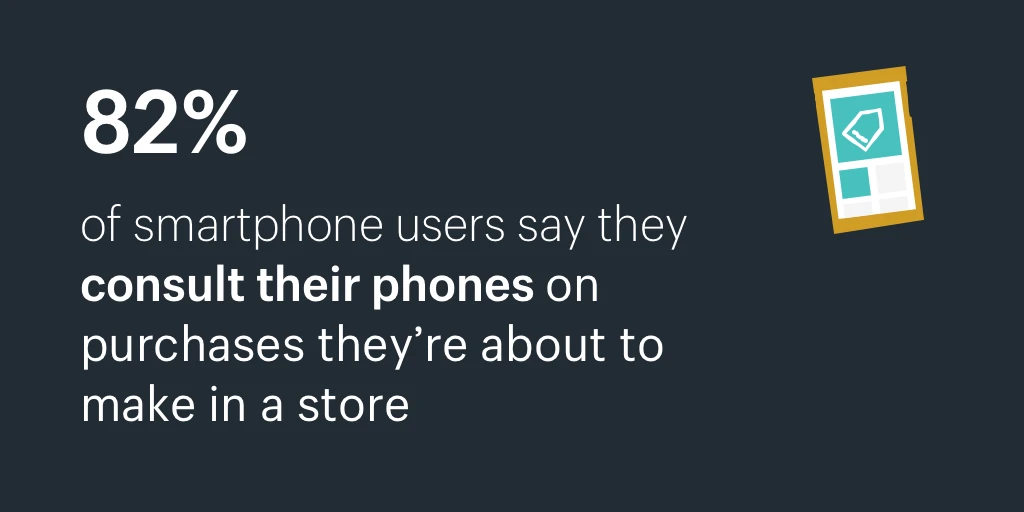
When is mobile commerce not right for a business?
Developer time is limited
Developing your own mobile app can be time consuming. Before investing in your own, consider whether you have the time to maintain it.
Experts recommend allocating 20% of the app’s initial development cost to ongoing maintenance. Fixing bugs, releasing new features, and maintaining functionality with mobile software all eat into the time (and money) spent updating your mobile commerce app. Justify whether that’s a price worth paying.
That being said, retailers don’t need to invest in their own native app. Plug-in mobile commerce like Shop Pay allows merchants to have a mobile storefront, faster checkout, and increased brand awareness and loyalty.
If you are just starting out or have budget constraints, I would focus on giving your customers a highly polished responsive website experience. Mobile websites are cost-effective compared to native apps, and it will also be easier for you to market and reach your target audience."
“The lines between a mobile web experience and a native app are growing ever closer. Ask yourself: “Why do I need a native app?” You might find that the on-device capabilities you crave are actually now available within a browser and mobile website.” —Tim Baker, Director of Stamford Digital
Your target customer isn’t an active mobile user
While smartphone usage is on the rise, it’s worth noting that the internet penetration rate isn’t 100%. Research shows just 61% of people over the age of 65 own a smartphone. This generation also spends the least amount of time on their smartphones, making a mobile commerce strategy less of a priority if your target demographic is older.
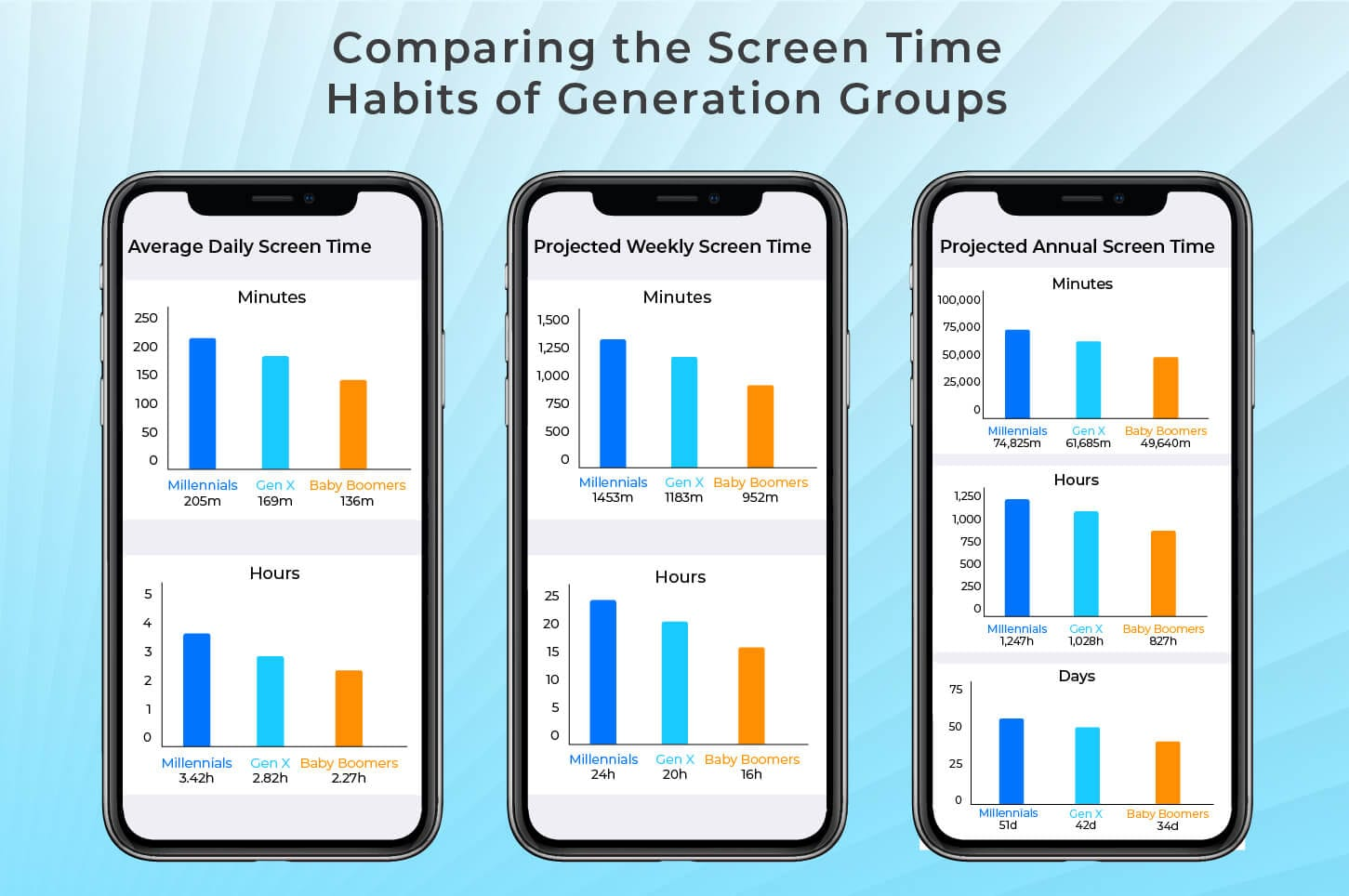
Similarly, think about the countries your target customer lives in. Mobile shopping is trendy in some areas of the world but not in others. Just 31% of online shoppers in Belgium and 32% in Japan bought something on a mobile device in Q3 of 2020.
Mobile commerce trends and statistics
1. Prioritize a mobile commerce platform over design trends
First things first: “Responsive design is not mobile optimization.” That was the thesis—and headline—of Shanelle Mullin’s masterful article on CXL. Within the piece, Talia Wolf offered this distinction:
“Though responsive design is much better than having to ‘pinch-and-zoom,’ it isn’t an optimized experience for mobile visitors. At its core, responsive design makes the desktop experience look good on mobile, but it doesn’t address the specific needs of mobile visitors.”
In the case of ecommerce, a caveat is in order. While the “needs of mobile visitors” must certainly be respected, what matters is marrying their needs with your own. After all, a delightful user experience (UX) is worthless if it doesn’t culminate in sales.
At the enterprise level, it’s easy to get seduced by mobile design trends instead of investing in proven optimization tactics. How can you unearth the difference?
You start with the platform you’re hosting on. Shopify Plus’ ecommerce platform has mobile commerce features—including a built-in mobile shopping cart, responsive theme, and push notifications. Your customers can shop anywhere, on any device.
“With our previous ecommerce provider, we had to create the whole mobile site. Shopify Plus is optimized for mobile, which really lets us fine tune our user experience.” —Ralph Montemurro, founder of Monte Design
Merchant spotlight: Merchology
Corporate branded apparel and accessories provider Merchology learned via its analytics data that the majority of its mobile site visitors weren’t converting. The company needed to quickly redesign its ecommerce site to offer a mobile-first customer experience that would make checking out on a mobile device easier.
“Wouldn’t it be great if ordering from a mobile device was just as fast and easy as ordering from a desktop or tablet?” said VP of Marketing Nolan Goodman before redesigning the Merchology site.
Merchology’s team discovered that users were switching from mobile to checkout on their desktop. The company used the data to build a case to fix its mobile-first site design.
Two months after launching the redesigned mobile site, which offered a simplified and automated checkout experience thanks to Shopify Scripts, Merchology achieved astounding results:
- 340% YoY lift in revenue per mobile device
- 40% increase in mobile conversions
The scripts that helped to power Merchology’s native mobile checkout powerhouse include:
- Automated discounts. Individual product discounts are applied automatically, enabling customers to immediately see the discounts they’ve earned in their carts.
- Dynamic pricing. To reduce the number of steps to checkout, Merchology created its own custom code with Shopify Scripts that looks inside a customer’s cart, identifies when they’ve made a change, and automatically adjusts the price in real time
“Simplicity drives sales regardless of device,” says Nolan Goodman, VP Marketing at Merchology. “We’ve made it simple to order and check out regardless of whether a customer is using a desktop computer, tablet, or mobile device.”
2. Rely on social commerce features
In the minute it’ll take to read this paragraph, almost 350,000 Instagram Stories will have been posted. Another 150,000 Facebook messages will have been shared. Nearly 70,000 people will have applied for a job on LinkedIn.
Social media has become central to our livelihoods, and our reliance on mobile devices fuel the addiction. The vast majority (91%) of social media users access their favorite platforms using a mobile device.
But these days, social media apps are no longer used just to chat with virtual friends. Some 54% use social media to research products. Platforms like Pinterest and Facebook play a role in mobile shopping, with 47% and 15% internet users using them, respectively.
That’s why you must invest in a social promotion and advertising strategy to increase mobile traffic and conversions on native social selling channels, including:
Social commerce is on the rise, with Snapchat as the latest social app to ramp up their strategy by introducing AR to create immersive shopping experiences, used by global brands like Prada, and Estee Lauder. In 2021 and beyond we will continue to see shoppers gravitate toward social purchasing.”
—Alex Sweany, Customer Success Lead at Searchspring
The downside? You’ll be pressed to find a retailer who isn’t using social media to fuel its mobile marketing strategy. Standing out from those can be tough.
Live shopping is one mobile commerce trend we’re expecting to see increase in 2021. Platforms like Instagram and Facebook have their own live streaming options. To cater to both the shopper and the merchant, each feature allows brands to link directly to the products they’re talking about.
The success of your social commerce strategy hinges on the direction you’re pointing social shoppers to. In most cases, linking directly to the product in question delivers a better user experience:
“A smartphone has a limited size as compared to a desktop or a laptop. Therefore, a consumer using a laptop will have to keep navigating in search of a product instead of just clicking directly.” —Felix Maberly of Tiger Supplies
Merchant spotlight: MVMT
Shopify Plus customer and watch retailer MVMT already had a mobile-first designed ecommerce site when it launched a Facebook Shop in 2014—around the time that mobile usage surpassed desktop users for the first time. That’s when the company saw its mobile usage increase to 60% almost overnight.
The MVMT team wanted to “cut out steps in the purchasing process” and make it easier for social media users to buy directly via their favorite social networks.
But MVMT couldn’t have achieved these results without a mobile-commerce approach to advertising. In fact, its success on Facebook, Instagram, and Pinterest earned the company official case studies on all three platforms.
On Facebook, MVMT’s use of carousel ads generated 1.8x higher CTRs and 3x lower CPA. MVMT learned that 75% of the revenue generated from its Facebook Shop came from the three products displayed most prominently on its profile.
On Instagram, MVMT doubled its engagement compared to other channels, strengthened brand awareness by 75%, and lowered CPC by 20%.
On Pinterest, MVMT’s campaigns, which initially resulted in a 2x lift in conversions and higher average order values, have seen as much as 10%–20% in additional sales after a Promoted Pin has been paused.
When people see something they love, they want to buy it immediately. It’s easy to get lost on a website. So we started thinking about how to make commerce easier for social media users.”
—Spencer Stumbaugh, VP of Marketing at MVMT Watches
3. Facilitate mobile click-to-mortar
Mobile commerce lies at the heart of an omnichannel retail strategy—especially one that spans both online and offline.
Data shows that people rely on their mobile phones for in-store shopping. Half of people use their mobile device to research a product; another 27% have purchased a product from their mobile device while visiting a brick-and-mortar store.
Work to combine this online-to-offline (and back again) shopping experience with click-to-mortar incentives. They align your in-store experience with mobile shopping.
Using QR codes, mobile-specific comparison pages, and geo-fenced SMS coupons, and prioritizing FAQs on mobile are just some of the methods large and medium organizations can try to facilitate the back-and-forth mobile users are already doing.
The lowest barrier to entry? Buying online and collecting in-store (BOPIS). Some 59% of shoppers are interested in online shopping and collecting their purchases in-store. Interest is up 30% since the start of the pandemic.
Many companies are turning to mobile-enabled in-store checkouts and mobile wallets for customers who have been pointed to their store by a mobile device. Long lines in-store can be a major drag. Mobile point of sale (POS) devices—like PayPal, Square, and Shopify POS—offer an easy-to-use and cost-effective solution.
“I was looking for a 38-inch slim fit pair of trousers at a store last week. They didn’t have it in stock, so ended up leaving and not placing the order. Had there been a QR/NFC code, I probably would’ve just purchased it in the correct size online. I wasn’t going to take the time to find the website, then search for the exact product I was looking at in-store, and then place the order.” —Saul Sampson of Verbo
From ease and cost perspectives, there are no clear-cut answers. For NFC, you’ll need to get new terminals to have support. In most cases, the price of the terminal stays the same or you pay a premium that is ~$50. Bulk pricing also brings down costs.
So far, these omnichannel strategies have revolved around in-store applications. The demand to merge retail and mobile, however, also extends to before your customers step inside.
4. Offer one-click checkout
Not to be melodramatic, but mobile ecommerce lies or dies at the checkout. If only a small percentage of your online sales are coming from mobile users, you may need to refine your checkout process.
How? By following the golden rule: less is more.
Some 18% of people will abandon their online cart if the checkout process feels too long or complicated. Having to re-enter basic details like credit card numbers (30%) and shipping details (25%) is what causes mobile shoppers to head for the exit button.
Here’s where we turn to a few in-house advantages from Shopify Plus.
Ideally, once a user enters your mobile-checkout process, they should be presented with mobile-first payment options that enable them to purchase in a single click. On Shopify Plus, you can do this through:
- Shopify Pay
- Apple Pay
- Android Pay
- PayPal
- Amazon Pay
Include only those options that are most popular among your existing customer base. But remember: this doesn’t mean you should skip traditional logins and credit cards, as long as those methods have proven themselves as attractive to mobile shoppers.
Take Urban Planet as an example. Its mobile checkout offers an express checkout option: a choice between PayPal, Apple Pay, or Shopify Pay. Beneath is the traditional checkout process of entering billing and shipping information manually.
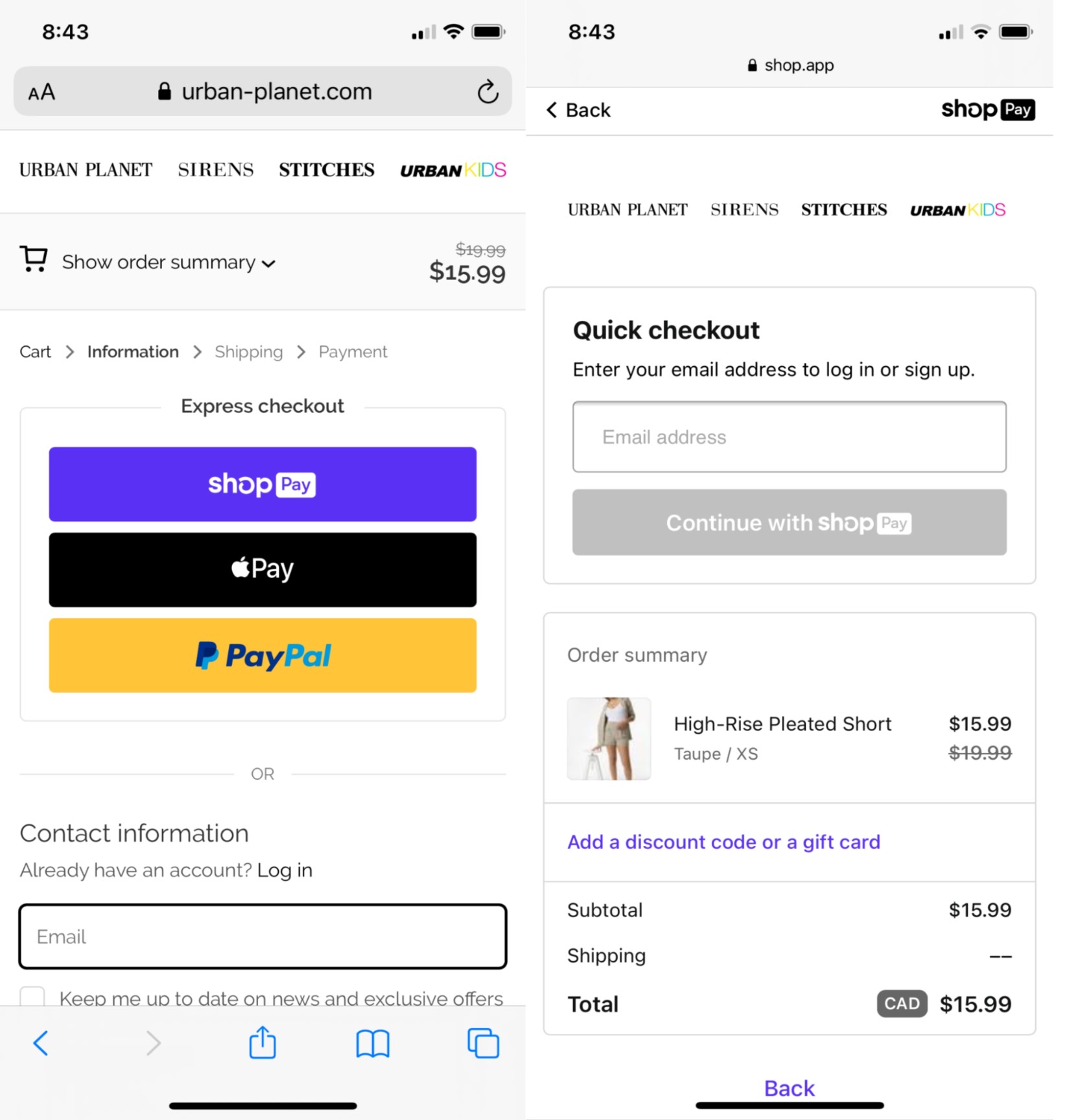
Shopify Scripts—which let you customize and personalize the entire cart-to-checkout process—can be used to show, hide, reorder, or rename payment methods during checkout based on products in the cart, customer group or tag, a customer’s shipping address, or their device type.
These express checkouts are so shopper-friendly that orders made using Shop Pay checkouts have a 1.72x higher checkout-to-order rate than those going through regular checkouts. This rate increases even more—to 1.91x higher—for mobile users.
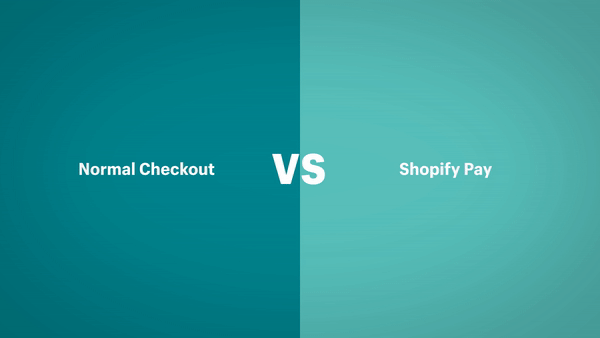
Lastly, Dynamic Checkout flows offer your mobile customers the ability to check out single products directly on a product page. The code recognizes their preferred payment method (such as Apple Pay) and displays a simple CTA button for people to purchase in just one click.
Some of the key benefits of installing a dynamic checkout button include:
- Accelerating mobile conversions by reducing the number of steps to complete a purchase
- Delivering a personalized mobile checkout experience by serving up your customer’s preferred payment method or wallet
- Capturing customer intent earlier with a custom checkout button, which appears directly on the product page and circumvents the need to add a product to the cart first
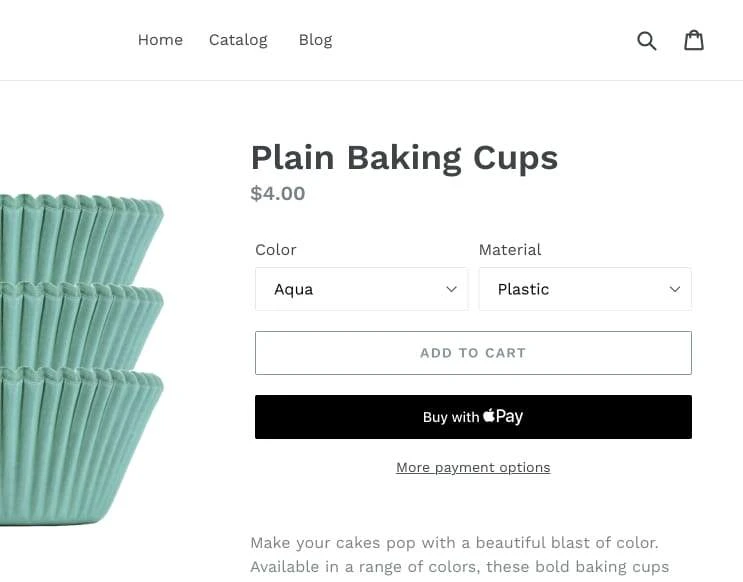
5. Leverage in-app push notifications
If you’re facilitating m-commerce through your mobile app, push notifications work to get users spending more time shopping through it. They’re notifications that show on customers’ smartphones, usually announcing limited-time sales, promotions, or launches.
These push notifications have been found to increase app engagement by 88%. They get disengaged users back, too, with 65% returning to an app within 30 days of the push notification.
Amazon, for example, uses push notifications to deliver shipping information. It nudges users back toward its app to track shipping. (Once they’re there, users will see a whole host of personalized product recommendations continue the purchase journey and enforce brand loyalty.)
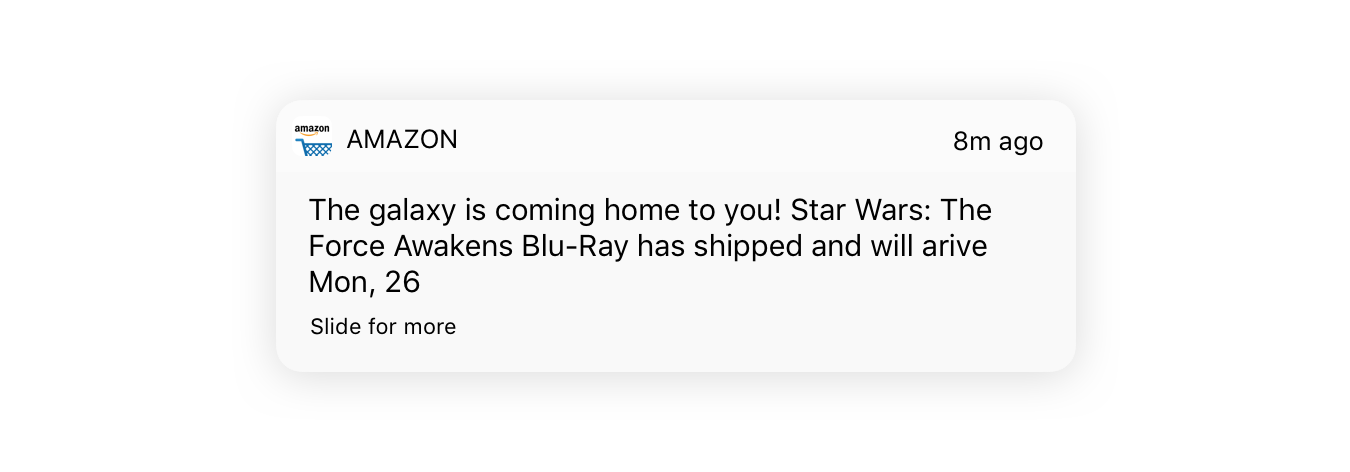
While push notifications can be effective, customer sentiment toward them can quickly change. Almost three-quarters of app users say push notifications feel spammy if they receive too many. Another half tune out when they receive push notifications with clickbait.
6. Create personalized shopping experiences on mobile
The mobile web is both a blessing and a curse for ecommerce merchants. Users have short attention spans and are easily distracted by text messages and social media notifications—or whatever hilarious thing the barista just said in their favorite coffee shop.
To stand out, create personalized user experiences that help keep their attention long enough to convert them into buyers.
On a mobile device, you need to help customers find exactly what they’re seeking in just a few seconds—while using less real estate than on a desktop to make your sales pitch.
Personalizing product recommendations based on the traffic source of new visitors is a smart strategy.
If a user arrived on your homepage after a search for hockey equipment, consider moving product recommendations for hockey players higher above the fold to help with relevant product discovery.
When visitors enter your URL directly or arrive at your site via a generic search, you can use Tinder-style product discovery widgets on your homepage to quickly introduce users to popular products.
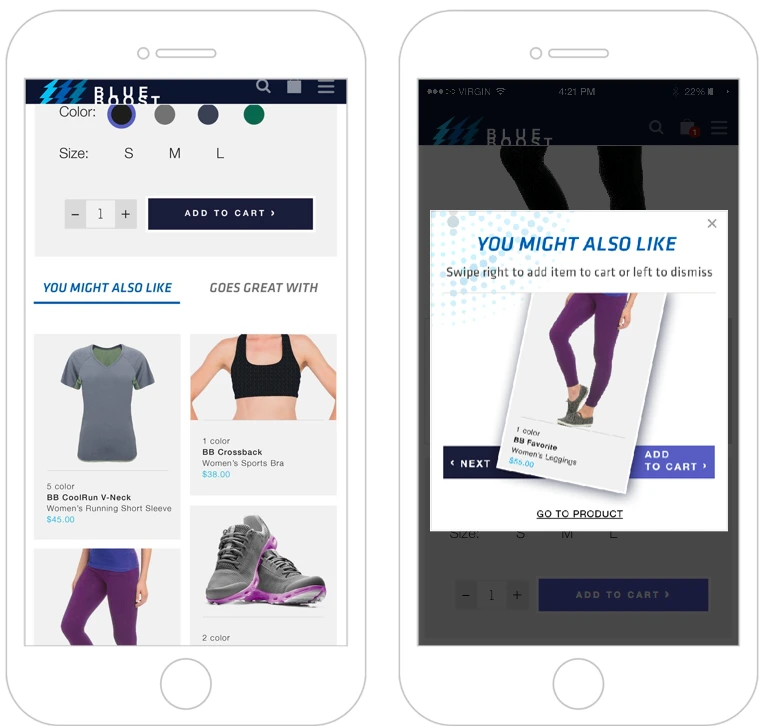
Another simple, yet emotionally impactful way to personalize a user’s experience on your site is by identifying their IP address to deliver custom free shipping offers.
Throughout their shoppers’ mobile journey, Fashion Nova automatically updates the free shipping threshold based on the current cart value.
For example, when a user adds items to their cart on your site, a message can dynamically adapt to reflect the value of items relative to the free-shipping threshold.
If the first message displays “FREE SHIPPING to TORONTO with a $50 purchase” and a user adds a $25 product to the cart, it’ll change to “YOU’RE $25 AWAY FROM FREE SHIPPING” to encourage users to buy more.
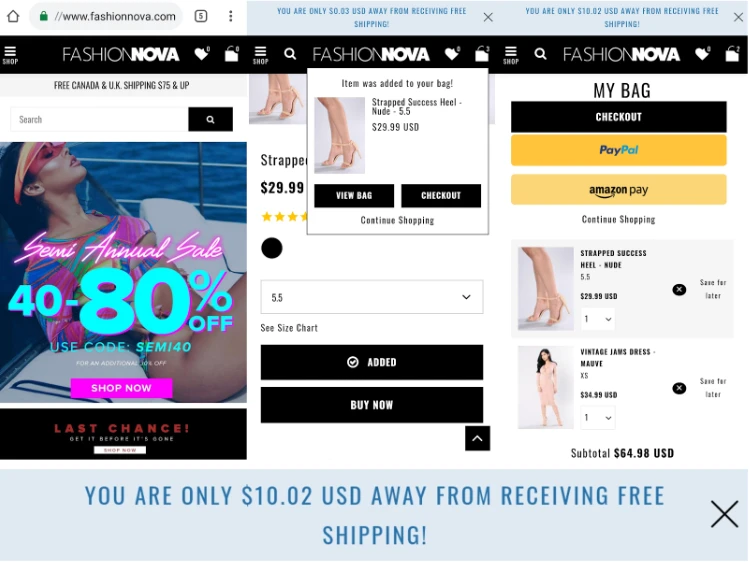
7. Leverage mobile chatbots
Emails are a tried and proven way to encourage customers, through reminders and special offers, to buy the items they left behind in their checkout cart. But chatbots are quickly gaining ground in this area—either in conjunction with or instead of emails.
Chatbot usage grew by 92% in 2019, making it the fastest-growing communication channel. They’re quickly becoming the first point of call for mobile shoppers, with 80% of customers who’ve used one reporting a positive experience.
According to Finastra:
Chatbot integration in mobile banking apps will be the dominant channel for chatbot-driven customer communications, accounting for 79% of successful interactions in 2023"
“265 billion customer support requests are made every year, and it costs businesses a whopping $1.3 trillion to service them. Cost savings from using chatbots in the banking industry are estimated to reach $7.3bn globally by 2023.”
Gymshark is one retailer using social media chatbots throughout all stages of the mobile shopping experience. Its Facebook Messenger chatbot begins by asking customers what language they speak. The next automated message returns a selection of prompts—including My Order, Faulty Item, and Restocks—to give customers real-time answers to their query.
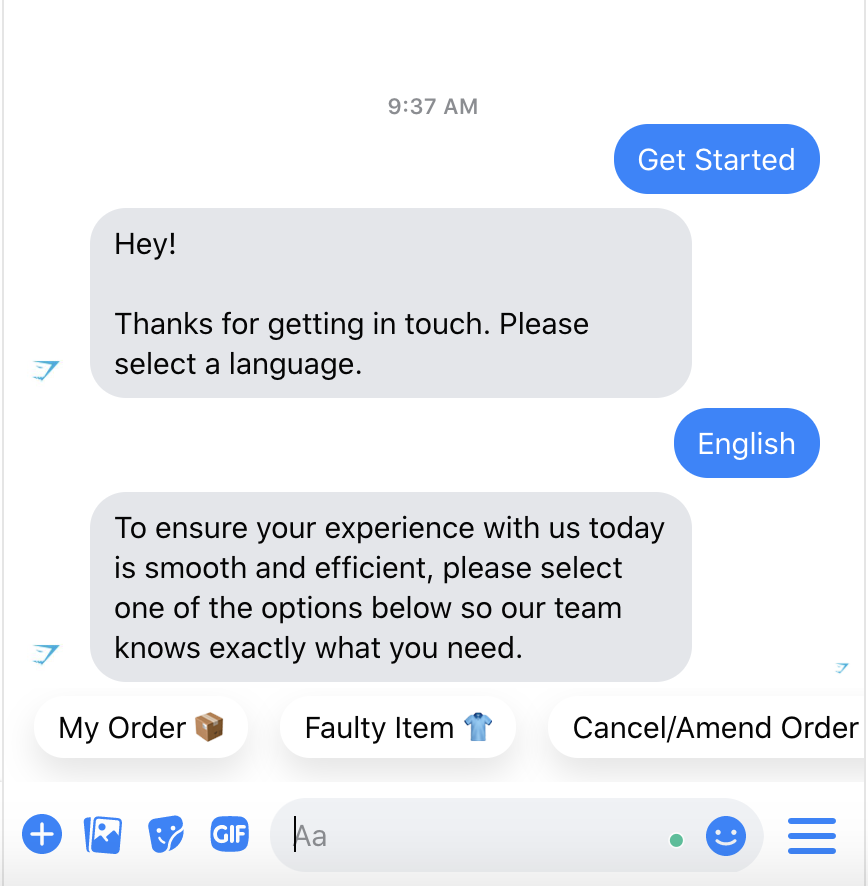
8. Prioritize mobile loading speeds
While it’s not the most exciting topic, decreasing a site’s load speed matters for attracting, acquiring, and keeping customers.
Mobile design maintains the aesthetic of its desktop counterpart, but in many cases, it fails to optimize behind-the-scenes elements that unnecessarily eat data. The result is a beautiful experience that visitors pay for in lengthy load times.
Some 61% of Google search results now come from a mobile device. Search engines are clocking onto this and penalizing sites that don’t deliver seamless mobile shopping experiences.
Google’s shift to mobile-first indexing, for example, takes the mobile experience of a site into consideration when determining where each page should rank—even if the searcher loads it on a desktop.
We’ve written extensively about how to improve speed and site performance here on Shopify Plus, and it’s no accident the very first step in that cornerstone guide reads: “Start by Testing Your Mobile Performance.”
Google PageSpeed Insights is the perfect starting point. It’ll show average loading times across mobile devices, with recommendations for fixing them.
Merchant spotlight: Honey Birdette
Honey Birdette is a lingerie retailer based in Australia. When it replatformed to Shopify Plus, it doubled down on improving site performance and converting mobile visitors. It worked with Shopify Plus partner The Working Party on its goals: to improve mobile site speed, the checkout process, and search filtering.
After the overhaul, the vast majority (80%) of Honey Birdette’s customers now visit the site on a mobile device. An improvement in mobile loading times and overall design are credited with the uplift.
9. Build an in-app loyalty program
Trying to drive installations for your mobile app? Loyalty programs are the second-most convincing reason to download a mobile app, beaten only by coupons or special deals.
Loyalty programs incentivized people for making repeat purchases. Most often, they’re a points-style system, whereby customers accrue points on each purchase. Those points have monetary value and can be redeemed on future purchases.
However, app loyalty programs don’t have to sacrifice profit margins. Fashion retailer In The Style regularly collaborates with influencers on product launches. Its app loyalty program centers around that: shoppers who’ve downloaded the app get to shop the new collection an hour before they’re added to the main website.
The best part? Investing in a mobile app loyalty program pays dividends in the long term. After receiving a reward or incentive, consumers are more likely to share their experiences with friends, leave a positive review, and make a repeat purchase.
10. Use augmented reality
Augmented reality (AR) has come a long way in recent years. What once felt like an expensive investment is now accessible to most medium to large companies.
One technology advancing faster than others is virtual fitting rooms. Shoppers can use their mobile devices to livestream their body. Augmented reality places a 3D model over the live stream so shoppers can see what the product looks like.
In the challenging times of COVID-19, where hygiene is a big concern, consumers will be less prepared to physically try on products, and this is where augmented reality can replicate experiences without the health implications.”
—Ji Hyuk Park, Nielsen Commercial leader in South Korea
Sephora’s app, for example, has Virtual Artist. It uses facial recognition software for customers to try on makeup in the comfort of their own homes.
Magnolia Market also uses Apple’s ARKit technology. Customers choose the item of furniture they’re thinking of buying and overlay the AR model of it in their own home. Not only is it more likely to combat high return rates (since most happen because the product looks different in-person), but the immersive shopping experience makes m-commerce fun.
Merchant spotlight: Rebecca Minkoff
Forward-thinking fashion brand Rebecca Minkoff uses “connected stores” to bridge the gap between online-to-offline (O2O) commerce.
By using data-driven omnichannel touchpoints, like smart fitting rooms, customers can:
- Try on clothes in-store
- Add items to their virtual cart via their smartphones
- Find sizes and variants (like color) not available in-store
- Execute mixed physical-and-digital purchases
Rebecca Minkoff added AR-powered technology to each product page of its mobile site. It showed a potential customer what the item looks like in real life.
By harnessing the data collected within its smart stores, and connecting it to additional customer devices and touchpoints, like its website, Minkoff increased sales by 6–7x within the first five months of launching.
- Shoppers were 44% more likely to add an item to their cart after interacting with it in 3D
- Customers are 27% more likely to place an order after interacting with a product in 3D
- Visitors are 65% more likely to place an order after interacting with a product in AR
Don’t forget about mobile accessibility
Many state and federal laws in North America and Europe are becoming sensitive to the needs of disabled citizens. Large enterprises and SMEs alike are facing Americans with Disabilities Act (ADA) and Section 508 lawsuits—especially since 4.1 million in the US report difficulty using a phone.
Shopify Plus Partner Something Digital advises that merchants engage in accessibility exercises to ensure compliance—as well as avoid litigation—as part of their IT and marketing calendar.
Unfortunately, the majority of the mobile web is not built with accessibility in mind.
Many sites even prohibit users from taking advantage of the accessibility or personalization features of modern smartphones.
“Increasing a site’s accessibility helps website visitors do what they came to do. Things to check on mobile include making sure text is large enough to read and buttons have enough space from other clickable items.
Check that important content isn’t only visible when a user hovers over an item, as users can’t hover on mobile. Mobile use may be an indicator that a user is multitasking—looking after a child, watching TV, etc.—or on the move. Accessible sites help all users complete tasks on a site, increasing the likelihood they’ll complete a purchase.”
—Dave Smyth of Scruples Studio
Shopify’s Liquid template technology allows store owners to add accessibility features directly from their store’s back office.
According to Something Digital, web developers can use Aria attributes to let browsing platforms know that accessibility features are enabled on a site. These attributes can be added to plain HTML, which essentially tells the platform: “If you’re looking for where to start with accessibility, here I am.”
This goes a step beyond plain old semantic HTML, which describes the type of content and details its purpose.
For screen readers, the most important element of site design is the ability to maintain focus. When a link is clicked and displays a modal window, for instance, the focus should be moved to that modal.
Once dismissed, the focus should then be returned to the prior link or text area from which it was stolen. Something Digital doesn’t advise removing modals altogether; instead, consider whether using them is necessary or common practice and approach them with accessibility in mind.
By replacing iconography with simple text instructions, mobile users can benefit from the smaller page sizes. Plus, by implementing common keyboard navigation techniques to menus, web crawlers such as Google can understand and prioritize navigation structures on your sites.
Another best practice is using browser plug-ins to test out designs that emulate common color blindness. With these plug-ins, you can find potential issues with conversion, such as drawing attention to your calls to action.
Begin by performing a quick check of your site. There are many tools online to test simple ADA guidelines like font size and colors, including:
To learn more, you can read about the ADA Guidelines. After performing a quick self-assessment, reach out to a knowledgeable Shopify Plus Partner agency like Something Digital to continue the conversation about a UX audit and accessibility primer.
Examples of great mobile commerce
Emma Bridgewater
British home and kitchen brand Emma Bridgewater experienced the impact of going mobile.
Improving mobile experiences was one of its greatest priorities when re-platforming. It changed the layout of mobile product pages and streamlined mobile checkouts.
The result? Emma Bridgewater saw a 32% increase in mobile users, contributing a 13% uplift in mobile revenue. Those changes lead to a record-breaking £190,000 sales day immediately after migrating.
“It looks much better than our old site did on mobile, and it functionally works much better. It feels like we can do much more now and Shopify Plus can help us make it even smoother.” —Samantha Marsh, Ecommerce Manager, Emma Bridgewater
LOOKFANTASTIC
LOOKFANTASTIC is a beauty retailer that doesn’t go the traditional route with its mobile app. David Gossage, SEO Manager, explains that “mobile visitors tend to be higher up the conversion funnel. This means that they may convert less, but they read more.”
“With a world of information at their fingertips, [shoppers] will research a product before buying it and will absorb the content and may visit other sites to do so. Providing premium content within easy reach from your mobile site or app will not only aid the user journey when making a purchase, but can also drive more traffic via organic search.”
Because of this, LOOKFANTASTIC uses its mobile app to deliver exclusive digital content to its shoppers. Gossage reports this tactic keeps “users engaged, even when they are not currently shopping.”
SHEIN
Fast fashion retailer SHEIN is in the hall of fame when it comes to m-commerce shopping apps.
The company has estimated revenues of more than $10 billion. Part of its astonishing valuation is its mobile app, which overtook Amazon as the most-installed shopping app in the US back in 2018. Its iOS app currently has seven million monthly active users.
Shop App
Shop App offers express checkout options for customers shopping on mobile.
Shoppers can use the digital wallets—including Apple Pay and PayPal—already set up on their mobile phones. And, for those who don’t use mobile wallets, the native checkout stores a customer’s billing and payment information for one-click ordering.
The end result? An express mobile checkout that determines whether a shopper will complete their order.
A summary of mobile commerce in 2021 and beyond
There’s no doubt that mobile commerce is changing the way consumers shop. Both ecommerce and brick-and-mortar retailers can lean into the power of mobile shopping, offering mobile checkouts to visitors regardless of where they shop and what they buy.
Remember that the success of mobile commerce lives and dies at the checkout. Improve the mobile experiences already happening by offering various types of mobile payment—including in-app checkout, mobile wallets, and Shop Pay. You’ll soon start to see the surge of mobile visitors (and customers) on your site.
